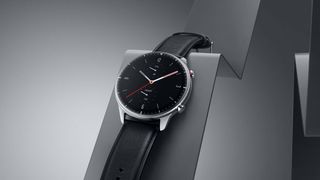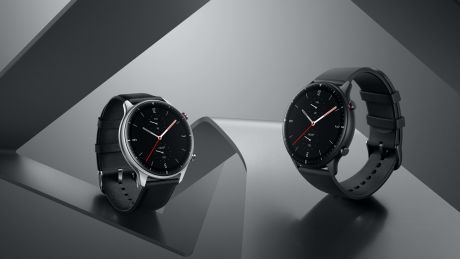Our Verdict
Impressive smartwatch with good fitness tracking, a two-week battery life and a superb screen.
For
- Beautiful looks
- Excellent value
- Superb screen
- Great battery life
Against
- No extra apps
- Confusing to navigate
- Poor voice recognition
- NFC supports only China’s AliPay
You can trust Coach
A little while ago, I reviewed the Zepp E and was rather keen on it. For £209, it did just enough to warrant a four-star score, based on its excellent looks, superb screen and basic but streamlined interface.
Now Zepp’s new owner Amazfit has launched the GTR 2 – and it’s basically the same, only with added GPS and other extras for £50 less.
While it’s undoubtedly a barebones experience that can be more than a little confusing to get your head around, this is an excellent smartwatch at a very competitive price: it looks stylish, it lasts for up to two weeks on one charge and it has a superb screen.
Serious athletes may favour something from Garmin or Polar, and those that like a social experience may fancy a Fitbit, but for anybody who just wants something that’ll do the job without breaking the bank, the Amazfit GTR 2 comes highly recommended.
Buy from Amazfit | £159
See related
Amazfit GTR 2 In-Depth
You might assume the most sensible comparison point for the Amazfit GTR 2 to be the Amazfit GTR but, while there are similarities between the two, it feels closer to the Zepp E. Amazfit now owns the Zepp brand so the devices have a custom OS in common, which is a huge improvement on the original GTR’s somewhat clunky interface.
In fact, there are improvements across the board, though very little that would actually be picked up in a comparison GTR vs GTR 2 specs table. For one thing, it feels considerably smoother when moving from menu to menu. It also looks nicer, with the bezel and watch face blending into one disc, rather than the chrome edge the original favoured.
Design-wise, however, the two GTRs are pretty similar. Both have 1.4in (36mm) faces and two buttons on the right-hand side alongside touch controls. They’re so alike, in fact, that I was able to sub out the rubber GTR 2’s rubber straps for the faux leather ones that came with my original GTR.
The GTR 2 improves over the original with 4GB of onboard storage for music, a diamond carbon surface to make it resilient to scratches, a speaker and the ability to conduct phone calls from your wrist, if you’re prepared for the odd looks you’ll get as a result.

While the battery is technically larger (471mAh vs 410mAh), the average battery life is considerably lower, promising only 14 days to its predecessor’s 24. No reason is given for this, but it likely comes down to the extra grunt of the processor and power-hungry operating system. While it’s disappointing that Amazfit’s legendary battery life is gradually slipping (the Amazfit Bip promised over a month with GPS), most people would still say two weeks is more than enough for a smartwatch – and it certainly eclipses the day-long life of the Apple Watch or any watch running Google’s Wear OS.
What’s less acceptable is the watch’s implementation of NFC. It’s there for contactless payments, but only if you use AliPay – a system that isn’t widely used outside of China.
Smart Features On The Amazfit GTR 2
As expected, the smart features of the Amazfit GTR 2 are largely the same as on the Zepp E – that is to say, pretty limited. You’re basically looking at notifications, the ability to play music and weather updates, with no app store to expand things further. For me, and anybody else who just wants a gateway to their phone rather than a computer in its own right, that’s absolutely fine. Anybody wanting Google Maps or Spotify on their wrist will be left disappointed.
The Amazfit GTR 2 should be getting Alexa support soon. I couldn’t find a way to enable this at the time of writing, so I assume it’s coming in a future update – but I could test the OS’s own voice controls and found them wholly unimpressive. For starters, you activate the microphone by quickly swivelling your wrist, at which point a tiny listening icon appears. From there, you can theoretically control the wearable’s functions… but I really wouldn’t bother.
Not only do you have to be very exact with your phrasing (“go to weather” does nothing, but “open weather” does), but I found speech recognition to be lousy. “Start running” was detected as “start climbing”, which instantly opened the climb tracking without checking to make sure it heard correctly. Worse, “turn the brightness down” did exactly the opposite.
It’s possible – likely, even – that the introduction of Alexa will improve things considerably, given how much longer Amazon has been in the speech recognition game. But for now, voice commands are a feature you definitely won’t get much use out of.
One final feature worth noting: it’s possible to answer calls from your wrist, thanks to the built-in speaker and microphone. This requires additional pairing with your phone, but once in place it works well enough – very much as if your handset’s speakerphone setting was moved to your wrist. Personally, I can’t ever imagine using this as an alternative to answering my phone directly, but it’s nice to have the option, I guess.
Tracking Activity With The Amazfit GTR 2
Fitness and wellbeing are the main focuses of the Amazfit GTR 2, and it’s pretty well equipped with support for 12 exercises via a press of the bottom button: outdoor running, walking, outdoor cycling, treadmill, indoor cycling, open-water swimming, pool swimming, elliptical training, climbing, trail running, skiing and the catch-all “free training”. These, as with all fitness watches, vary wildly in usefulness with the built-in GPS essential for outdoor activities, but less helpful for gym-based sessions.
By default, a swipe to the left reveals your PAI score, something Amazfit has introduced in its recent wearables as a simple figure to signify if you’re keeping fit and healthy. It stands for “Personal Activity Intelligence” and measures the amount of intense physical activity you do, along with your heart rate and other factors to give you a number. Keep it over 100, and you’re likely to avoid cardiovascular disease and live longer, according to the HUNT Fitness study from the Norwegian University of Science and Technology’s medical school.

On top of this, the watch will also keep track of your steps, fat burning time and standing times with three circles that slowly fill in throughout the day. Complete the goals for all three, and you’ll be achieving a decent level of activity every day. It’s a touch basic, but fine for the kind of casual exercisers the Amazfit GTR 2 is aimed at.
There are also a couple of other extras: first, the ability to measure stress (the physical rather than necessarily the mental kind) via the heart rate monitor. This requires you to sit perfectly still while the watch takes a quick measurement, and it can be done in the background too, if you want the rolling data over days and weeks. It’s all very well and good, but it’s slightly weird that it doesn’t include – as the Amazfit Band 5 does – guided breathing exercises to reduce stress alongside the measurement. Here, you’re just left with an assessment of your stress, with no helpful way of alleviating it.
Then there’s blood oxygen saturation levels, measured via an SpO2 test. It works a similar way to the stress test above, and then gives you an estimate where anything under 90% could be cause for concern. Getting an indication of an abnormally low blood oxygen level is a useful nudge to get a check-up, although the watch isn’t a medical grade device and shouldn’t be relied upon as such.
Running With The Amazfit GTR 2

Running with the Amazfit GTR 2 is a pretty agreeable experience. GPS didn’t take long to lock on, compared with the Garmin Forerunner 245 on my other wrist at least, and plenty of information is available to follow during a run. Most of it requires swiping to view, though, which means that you’re likely to be staring at the four stats on the main screen: duration, distance, pace and heart rate.
As far as I can tell the main four can’t be changed, but swiping down reveals more stats, with three to a screen: average pace, cadence, speed, average speed, altitude and total climb.
There’s no always-on screen so it will go dark unless you wake it up with a shake of the wrist. This would be fine if it worked consistently, but sometimes I was shaking my arm for quite a while to coax it from its slumber.
Once your run is complete, all stats are tracked in the Zepp app for running nerds to obsess over. Its accuracy was slightly adrift of my Garmin Forerunner 245 – which has proven very close to spot-on – but not by much. Over the course of five runs, ranging from 3.5km and 4.3km in length, the GTR 2 was between 0.05 and 0.15km behind the Garmin which, while not perfect, is significantly better than some wearables I’ve tested – and certainly more reliable than piggybacking off a phone’s location data.
Heart rate measurements between the two were virtually identical: an average of 155 for the GTR 2 and 159 for the Garmin, with max bpm measured at 181 and 182 respectively.
Sleep Tracking With The Amazfit GTR 2

Like the Zepp E and Amazfit Band 5, there’s no mention of sleep tracking on the watch itself, but your data is quietly being recorded in the background, and it provides some interesting insights. Deep, light and REM sleep are recorded and graphed if you’re asleep for more than 20 minutes, and this data can be viewed from a daily, weekly or monthly perspective to help you keep an eye on things over time.
It does this by comparing you with others as well as yourself. In other words, it’ll not only tell you if you went to bed later than usual, but also if you got less deep sleep than the worldwide average of its users.
Neatly, you can also add what you did before bed – from playing games to having a bath – so you can judge over time if a certain pre-sleep ritual seems to have an appreciable effect. The app will also offer its own insights on how to improve things, but they’re pretty obvious suggestions: more exercise, less caffeine and avoiding screens before bed.
In short, it’s solid, though like everyone else, it seems Amazfit isn’t really sure what to do with all the sleep data it’s collecting. But if it interests you, it’s all here.
Battery Life On The Amazfit GTR 2
Battery life has always been a strength with Amazfit products, and while the GTR 2 doesn’t have the superhuman stamina of the Bip, the company’s estimate of two weeks feels entirely right – assuming you don’t want continuous heart rate monitoring and the always-on screen enabled.
Even with both of these enabled, and with multiple GPS-tracked workouts, it was easy to lose track of where I’d put the charger because it needed plugging in so rarely. In essence, battery life really isn’t a problem, which is pretty praiseworthy considering what the GTR 2 offers.
Where Can I Wear The Amazfit GTR 2 Without People Laughing At Me?

Laughter won’t be a problem. The Amazfit GTR 2 is one of the nicest-looking smartwatches I’ve seen, and the always-on display means you don’t need to do the slightly awkward thing of waking up the screen whenever you want to know the time.
It’s certainly unlikely to win over those who love their traditional mechanical watches, but it’s up there with the Moto 360s, Galaxy Watches and Apple Watches of this world, for sure.
Should You Buy Something Else?
At £159, the Amazfit GTR 2 is really impressive. The screen is terrific and the whole thing looks great, and while it doesn’t have the range of apps of some of its rivals, what is there is decent and well thought through. It feels a lot like the Zepp E – a brilliant watch that sells for £50 more without built-in GPS.
But there’s stiff competition in this price bracket. The Fitbit Versa 3 is £40 more but has a real ace up its sleeve: the excellent Fitbit app and Fitbit Premium service, which work with the device and coach you towards healthier habits and greater fitness.
Alternatively, for those that obsess over the metrics of every workout, it’s hard to go wrong with a Garmin, and while the older Garmin Vivoactive 3 now sells for around £130, the just-released budget smartwatch Venu Sq is a better bet at £179.99. If you’re a Spotify Premium user, the music version for £230 allows you to sync playlists across to the device to listen to away from your phone.
Alan is a freelance tech journalist and mostly covers fitness trackers for Coach.
Alan was not what you would call a big fitness guy growing up, but has been radicalised by parkrun and taken up running in a big way. Although nowhere near podium at races, as a late starter he does at least know that he can still get faster. Alan has written for ShortList, Tom’s Guide, Trusted Reviews and Expert Reviews, among others.

Coros Vertix 2S Review: The Garmin Fenix Rival Gets Some Useful Upgrades

I Tried CrossFit Champ Mat Fraser’s Signature 40-Minute EMOM And It Helped Me Build Strength, Skill And Endurance In One Fell Swoop

I Took A Test To Find Out If I Had What It Takes To Be An Elite Athlete And It’s Changed My Training For The Better

